The Apex, without a doubt, is the new summit in my headphone Hi-Fi journey.
During the past few weeks I’ve been going through the Bryston BDA-1 and Audio-Gd Ref7.1 systems which I’ve been tweeting quite enthusiastically about. Two or three months before that, I was really raving about the Manley amps, during which I did a review of the $5,000 Stingray amp, and also spent some time with the $6,000 300B Neo-Classic preamp. And this past year I’ve spent a lot of time with just about every flag ship there is in the market. But I can definitely say that the TTVJ Apex out of the Ref7.1 DAC exceeds anything my ears have feasted on this year.
I’ve recently just sold the Zana Deux. It is a very nice amplifier, but I felt that I’ve spent too much time with it and just wanted to move on to something different. But then I didn’t have any idea what the next amp would be. The WooAudio WA5 is nice, but I don’t think that the 300B tube is right for me. One day I was talking on twitter, and @blessingx told me that I should give the Apex Peak a try. I’ve heard about the midline $2K amp from Todd for a long time now and I noticed that it has a vacuum tube input stage and a Mosfet output stage. I told blessingx that while I think that the amp would be a nice one, I wasn’t quite so sure about the Mosfet output. From experience they just don’t give the most transparent sound. But anyway I think it’s a good time to give the Peak a try and perhaps come out with an article about it. So I sent Todd an email.
The Jaw Dropping Sound
One day the Apex Peak and Volcano package arrived. The unboxing experience was quite special, but I won’t go into too much detail because that’s not where the focus is. The real revelation comes when it comes for me to give the Apex a try. I didn’t hook it up to the Bryston or the Audio-Gd Ref7.1 which I had laying around. Just for simplicity sake I hooked it up to the Fostex HP-A3 DAC/Amp. I just wanted to hear what sort of a tonality the amplifier had.
My jaw dropped to the floor. I don’t think I have ever heard an amplifier with this kind of a sound. First and foremost is the transients. The fastest transients I’ve heard on dynamic amps — it’s almost scary. And yet, with all this light-speed transients, the decay remained natural and flowing. There is no shrillness, sharp sound, or dryness in the sound. I don’t think I would ever write the words fast transients and smooth, but the Apex does just that. Gone is the day where I will long for the Omega2’s transients because the HD800 is just precisely fast on the Apex amp, and more.
Tube amps are not usually known for fast transients performance. Solid states can go pretty fast, but they can’t quite pull off the silky smooth sound that tubes do so effortlessly. This combination is perhaps the most jaw-dropping aspect of the Peak amp. Fast transients with silky smooth sound. The two adjectives that I almost never find coexisting together in one set up. The Peak doesn’t stop there though. Clarity is crystal clear like the air on the mountains. Zero grain in the sound, clean background of the soundscape, exceptional soundstage, the best and cleanest sound I have ever heard in a very long time.
I don’t think I’ve heard of a clearer treble with such an uncanny smoothness. There is no harshness to be found, not even 1 milligrams of it. Now clarity and smoothness is a very rare combination that you’ll only find in high end systems. The Peak does clarity and smoothness better than the Zana, better than the Stingray, and though it doesn’t have the low end body and the grand soundstage of the 300B Manley, the Peak clearly is the champ when it comes to treble quality.
The midrange clarity is among the best I’ve heard — rivaling the 300B Manley Neo Classic, though the Peak doesn’t have the same lush midrange body that the 300B Manley seems to be born with. From the midrange down, you get a round and punchy upper and mid bass. The bass never feels lacking, except for those of you looking for serious low deep bass, with which solid state is almost always the better choice.
From the utmost top treble to the lowest bass, everything flows in a very coherent, singular sweep. This may be hard to quantify, but when you listen to it, you will recognize it immediately. This is one of the aspect that more linear sounding solid state amps have a very hard time to pull out, including the AMB Labs Beta22 amplifier. The tonal balance of the Peak, with the Volcano power supply, and the stock Tung-Sol 6SN7 tube is fairly lean and tips to the bright side. If you want a full, lush sound, you’ve got to go to a different tube (more on that later).
The amplifier is so impressive, I know, that I’ve had trouble sleeping at night as I lie on my bed thinking about adjectives I would use to describe the Peak’s sound. Being a reviewer, sometimes it’s not easy to get excited about a gear, even after I went through about 10 different amplifiers in the last two months. I know some friends who’s ended up acquiring so much gears that in the end those gears become meaningless. And those are the moments when people finally get tired of the whole Hi-Fi world and decided to go to another hobby. But gears like the Peak really freshen things up to keep the passion in Hi-Fi gears going. It certainly is fresh enough to keep the passion in my reviewer’s ears.
Tonal balance on different tubes
With the 6SN7 Tung-Sol tube, which is the stock tube that the Peak comes with, the overall tonality is neutral, slightly thin and slightly bright. Yes, despite all those jaw dropping technicalities that I’ve mentioned on the previous few paragrahps, the tonality would be a little bright for general music listening, unless you’re using something very dark like the Audez’e LCD-2. This is precisely why the recommended upgrade for the Peak is the CV181-Z Grade A+ Shuguang Treasure Tube, listed on the Peak product page for an extra $135.00. Yes, consider it a must have upgrade since that’s how I get music to really flow with headphones like the Hifiman HE-500 and the Sennheiser HD800 (and most probably the Beyerdynamic T1 as well). And when it comes to DAC choices, the Peak tends to play better with dark and weighty sounding DACs, rather than the neutral or even monitoring DACs.
The Shuguang CV181 tube shifts down the frequency response entirely — here comes the lush sound with that J.Lo curve (the Tung-Sol sounds like Kate Moss). Less treble, more mid, more lows, darker, fuller, weightier on the lows. More mellow, more overhang, two steps slower on the pace. But things sound very good this way, at least for most music except for the die-hard metal and hard rock fans out there (which should be looking at solid state amps like the Burson anyway), the CV181 is what I would recommend people getting. The Shuguang makes the Apex Peak amp sound more like a 300B tube amp and it’s all good.
Short comparisons
I think the Peak is really one of the best out there. A few friends that listened to the Peak commented that it’s not exactly as impressive as the Zana Deux. And in some instances that’s true. The Zana still has an edge on detail retrieval and soundstage depth. But I’ve lived with the Zana long enough that I know what its weaknesses are: the grain in the sound, the tonality that focuses too much on the mids, losing treble and bass quantity, and while it’s moderately fast for a tube amp, the Peak is much faster in pace and is better for delivering PRaT. Another amplifier that I can make a comparison with is the $6,000 Manley Stingray amp with the 8 EL84 output tubes. The Manley in a way is a quick and lively amplifier like the Peak, and it excels in bass impact far more than the Peak. But when it comes to things like spaciousness, clarity, and smoothness, the Peak is still the better amplifier.
The Apex Arete Amplifier
Next up in the line up is the Apex Arete, which is like a twin brother to the Peak. Well that shouldn’t be surprising as both amps are like variations of the same design. The Arete uses a JFET voltage gain stage, where the Peak uses a 6SN7 tube. The output stage is the same single-ended MOSFET. So, there is no surprise that the sound is very close, with the exception of more grain presence, less smooth sound on the Arete. The tonality is slightly darker than the Apex Peak with the stock Tung-Sol tube (both out of the Volcano), and more low but less midbass than the Peak. The sound differs by precisely the same attributes that people give to solid state and tube. So, the Arete is the solid state version of the Peak, and vica-versa.
In real world applications (i.e music listening), several things stand out. First and foremost is the more neutral, easier to live with tonality of the Arete. The Peak with the Tung Sol tube would be too trebly for many, while the Shuguang may be too warm and too mellow. The Arete is in the middle, and it would be easier to live with the Arete if you listen to a whole different mix of music of different genres and different recordings. The mids are less full than the Peak (like always when comparing a solid state to a tube), and midbass punch felt less punchy than the Peak. Now I realize that a lot of people would argue that low-bass is ultimately what quality bass should be about (and the Arete is better than the Peak in low-bass), but for the mainstream Pop/Rock/Alternative/Jazz/Indie/RnB out there, the punchier mid-bass in the Peak would work better.
Plus and minuses there, I know, but at the end I would just conclude the comparison between the two as such: The Peak would give you the better Hi-Fi experience, the jaw-dropping factor. After all, if you go back and read the first few paragraphs I write on the Peak, you can tell that I was really inspired by that amp. The Arete, on the other hand, would be an easier amplifier to live with day to day, mixing different music in the playlist, it would just sound more right, more often. Hey take the car analogy here: the Peak is the mid-engine Ferrari. The Arete is the BMW sports sedan. While the Arete would be better for day-to-day music listening, the Peak is what will draw more crowd on a typical headphone meet (believe me).
The Arete, is actually a proper, high end solid state amp. It may not shine as bright next to the Peak (hey there are no tubes, the only light you get is from the LEDs), but in comparison with other solid state amps, I hardly think you can do any better than this. Short comparisons:
- Burson HA-160/HA-160D: The PRaT amp: more forward, better pace, better attack, better bass impact, but overall musicality goes to the Arete better except for Hard Rock, Progressive Rock, Techno, Dubstep, Electronic, RnB, anything that’s heavily dependant on beat and bass. For anything else I would go with the Arete.
- Graham Slee Solo amps: The Arete has a better resolution, is more neutral, less mid-centric, less mellow, more all rounder.
If you think of all the Pete Millet designed amp out there (you can check the collection here on Pete Millet’s DIY page), I don’t think you can find one amp that people describe as “dry”, “sterile”, “lacking musicality” or any of the other nasty adjectives reviewers use to a lousy amplifier. The track record from the Pete Millet and Todd-TTVJ team is super-solid and that’s the sort of reputation you get backing up the Arete and the Peak (which really doesn’t need any backing up since either one of the two amplifiers will prove itself once you listen to it.)
The Volcano power supply
I guess the next question is on the buy-it-now process. The budget and the wallet factor. The “hey Mike I am already going overbudget and I can’t shell another $700 for the Volcano” question. Okay, there is no doubt that the $700 Volcano power supply is the box everybody would want to have for powering their Peak or Arete amps. But how do things sound with the stock switching power supply that costs $0 and is included with every Peak/Arete purchase? I mean, $700 is a pretty big number and if I can live without the extra 10% oomph of the Volcano, I can put that $700 down for something else.
In a surprising turn of event, the switching power supply makes the tonality of the Peak easier on the ears by reducing treble quantity. Well that’s not so bad. I can actually save $700 and have an amplifier that’s less peaky as well? Not quite so, as in the process it also takes out the clean grainless sound, superb transients, other-worldly treble, basically almost all of those other jaw-dropping wow factor that I wrote about earlier. Is it still a good amplifier? Yes, but I’d probably opt for a Burson HA-160D or the Graham Slee Solo amplifier with the upgraded PSU-1 power supply for less than what the Peak is selling for. Sorry, but the Peak just lost the celebrity factor without the Volcano, so your wallet better be ready to take the hit. And no the performance loss is not 10%, I would quantify it at a whopping 25-30%, if you’re running the Peak without the Volcano.
Moving on to the Arete, I expected to get less performance hit on the Arete and that happens to be right. The performance suffers less with the Arete, and if I didn’t want to put another $700 on the Volcano, then I would be more comfortable with the Arete rather than the Peak. And guess what, with the switching power supply, the Peak lost all of any of the sonic advantages it had over the Arete. What’s more, the overall sound seem to be better on the Arete, if both amps are on the switching power supply.
I think I just heard a sigh of relief from your wallet. Well, maybe not, but you get the idea. $1K budget, go with the Arete. $2K+ budget, go with the Peak. $500 budget, let’s see how the Apex Butte measures up (separate article for that).
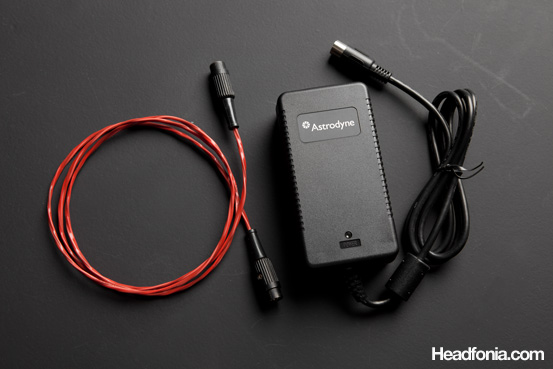
The supplied DC power cable for connecting the Volcano to either the Peak or the Arete (left). The switching stock power supply (right).
Headphone Pairings
Both the Peak and the Arete are built with a relatively high gain (23dB on the Peak, 21dB on the Arete). With the Sennheiser HD800, I listen on roughly the 9 O’clock mark. The LCD-2 is slightly higher than that, and the HE-500 is slightly higher than the LCD-2. The HE-6 requires the most gain, but the amps do a good job at driving the HE-6 roughly at the 12 O’clock mark. The amps sound great with all of the big full sizes I use on this review: HD800, HE-500, HE-6, LCD-2, provided that you know the character of the music you are listening to and use the proper headphone for that music. Due to the high gain, I wouldn’t recommend pairing them with an IEM, except if you happen to use something with very low sensitivity like the Etymotics ER4.
Build and functions
I have one complain about the build quality of the knobs they use on the front panel. I don’t think it matches the smooth anodized aluminum used for the casing and the front panel. The front panel itself is thick and solid, with very good quality anodized finish. The logo marking (silkscreening?) quality also needs to be improved. Other than that, everything else is first-class. The quality of the rotary switch and the volume control is very good. The indicator LEDs are also very intuitive. You get three pairs of inputs, with relay-based selectors. There is also a preamp out that’s muted when a headphone is plugged in. Functions wise, the Apex amps offers everything I would have asked for.
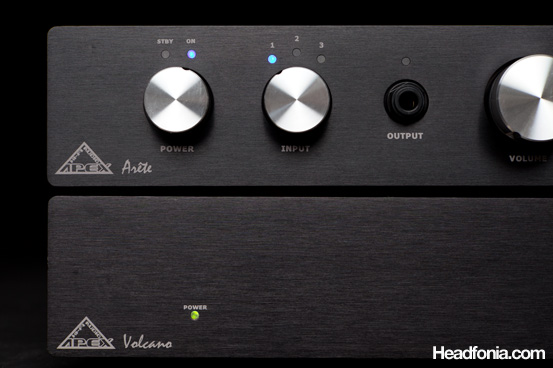
The LED on the amplifier turns blue when you turn the power on. Input selector LED also turns on to blue color. Notice the LED on the output jack is still out due to the muting function on startup.
End Words
I think I’ve said enough praise for the two amps throughout the article. The Arete would make for a very comfortable mid-high end amplifier at the $1K mark, and if future budget allows you can add the Volcano for a very noticeable improvement in sound (yes it’s not slight). The Peak should really be seen as a $2K+ purchase, as tube amps don’t run well out of switching power supplies. At the $2K+ mark, there is plenty of competition though (i.e the Zana Deux, the WooAudio 5), and though the Peak definitely belongs to the $2K+ league and more, you’ve got to do plenty of reading and auditioning to make sure that the amplifier you end up getting is what suits your music best.
Thanks to Todd at TTVJ.com for sending us the Apex amplifiers.
Gears used for review:
Audio-Gd Ref 7.1, Bryston BDA-1, CEntrance DACport LX, Fostex HP-A3, Sennheiser HD800, Audez’e LCD-2, Hifiman HE-500, HE-6, and many other smaller cans.





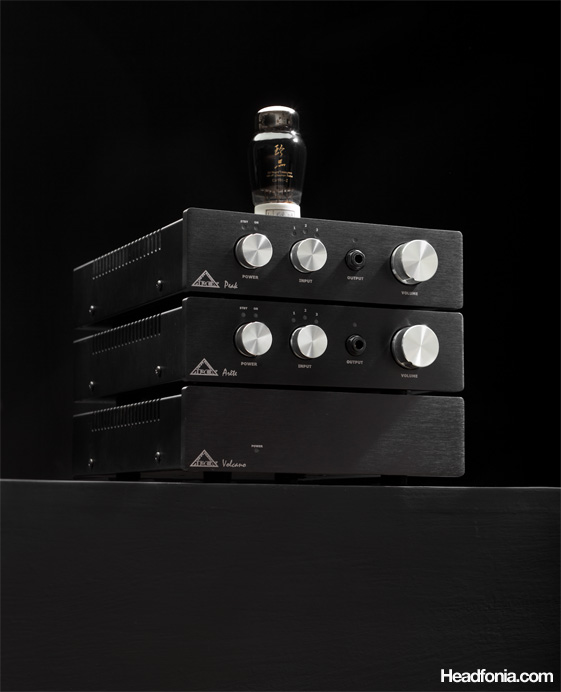
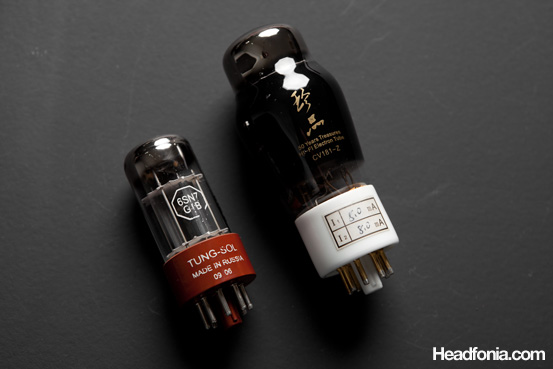
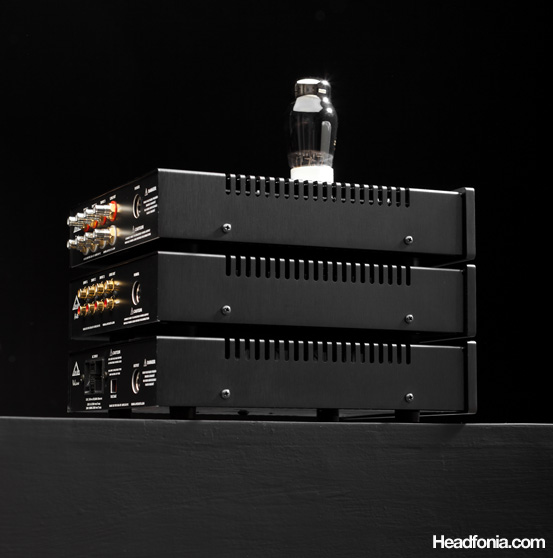

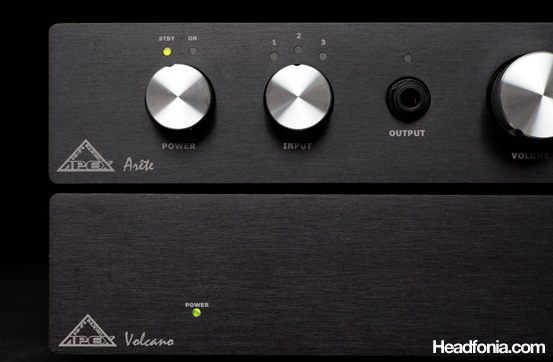


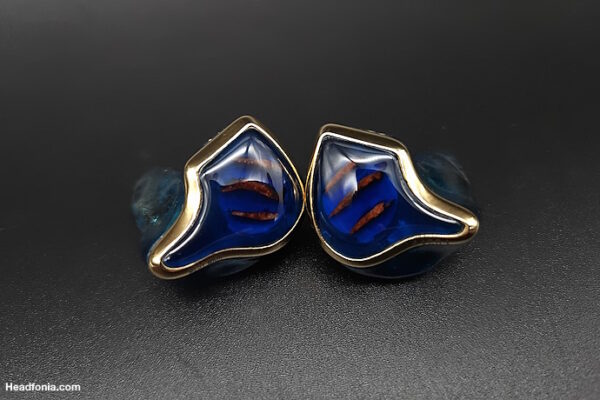
Anonymous
The Apex Butte will be reviewed on a separate article.
Lower Listening
Hi Mike, i was wondering what your thoughts would be on switching up from an SPL auditor to the peak/volcano? cans would be hd800. i found them good, but tad bright on SPL amp. thanks!
Mike
Definitely recommended. The Peak/Volcano is a very nice amp for the HD800, one of my favorite. It’s a lot more musical than the monitoring SPL amp. Don’t forget to get the CV181-Z Shuguang tube.
Brian Fu
FIRST!
Going to read the review now but gotta say the pictures look fabulous as usual especially the one where you stack all of them together.
Just wondering, can you use the Volcano power supply for the Arete and Butte?
Anonymous
Thanks, Brian.
Yes for the Arete, but not with the Butte. The Butte uses an AC-AC transformer adapter.
OnTheEdgeAustin
Just finished reading. Nice, you seem very impressed with both amps. I have a feeling this review will come in handy when I get some more money and when I consider purchasing a higher end amp. I was leaning toward the Zana Deux, but it looks like the Arête is shaping up to look really nice. Hmm, I wonder how they would sound with a air of Grado’s, since the Peak is rather bright as stated. Awesome review as always though Mike. Keep ’em up!
Anonymous
Thanks Austin.
So you’re looking at a high end amp now? Well, that’s always nice, though not for the wallet. 😉
Samhain
drolling…
really nice review mike.. cant wait for the butte review..
Anonymous
Thanks, Samhain.
Mick
On to the Apex Pinnacle any time soon?
Anonymous
LOL Mick, no actually I don’t have any plan to go there. 🙂
OnTheEdgeAustin
How would the Arete or the Peak pair with the HD650? I’ve heard the B22 speeds up the HD650 quite a bit and was opting for that….
Anonymous
Haven’t used the Peak with the HD650, but I would imagine it would add more pace to the HD650 more than the Beta22, and sounds better than the Beta22 too.
OnTheEdgeAustin
Mike, I decided that if I am going to enjoy what I have, I might as well save up and go big, but not as big as the Sennheiser HD800 or the LCD-2. Instead, the HD650’s warm and laid back sound sig will be nice for long listening sessions, and I’ll get a high end, speedy amp when I need more resolution. So yep, I’m going (almost) all out. 🙂
Anonymous
Yes that’s a good idea. also consider the HD600.
Anonymous
My friend Yaska stopped by today to try the T1 with the Apex Peak and he totally enjoyed it (even thinking about buying one now). I had a brief listen and I think the T1 will work very well with this amp, though I”m leaning more toward the fuller sounding CV181 Shuguang tube with the T1. I will try to spend more time with this combination (need to finish that ALO Continental review) before I send the amp back to Todd.
Achristilaw
I have the Peak (s/n 5) and the Arete (s/n 1) and the performance on the Peak…you haven’t even touched! You need to explore the WORLD of 6SN7’s and equivalents. The two tubes you used (the Russian “Tung-Sol” or the Shuguang “CV-181”) limit performance severely. My best performance is had using the Sylvania “Bad-Boy” or the Mullard CV-181 (the real deal!)
Anonymous
That sounds awesome, but unfortunately I have to move on to other reviews so I can’t dedicate so much time hunting every possible 6SN7s out there — there are just too many.
As a user that’s probably a good idea (and fun to do too) though.
If you can post your impressions of the tonality and character of the Sylvania Bad Boy and the Mullard CV-181, I’d greatly appreciate it.
cex
nice review mike.
however, i still love my zana than the peak, the peak sound warmer than zana to my ear, but yeah its totally different sound sig
Anonymous
Maybe I’ve had the Zana for a little too long. 😉
Albert
Hi Mike, what’s your thoughts of the Peak’s soundstage and 3D imaging? Is it deeper than wider or vice versa?
When you said that the Peak is faster pace and better PRaT than the Zana, how about its SQ in comparison to the Burson then? I think Burson is highly regarded for speed and PRaT traits. Are they stand on the same ground or way different league? Cheers.
Anonymous
It’s okay on width but very good with depth. In a way like the Zana Deux, though the Zana is still better on overall soundstage three dimensionality and ambiance.
Compared to the Burson, I think the Peak with the Volcano is a higher up, more refined amp. The PRaT is still better on the Burson though and I think the Burson is practically unmatched in that area.
Albert
Does Burson have more closed-in and smaller soundstage compared to the Peak?
Which one do you think drive the LCD-2 better?
Anonymous
Yes I think the soundstage on the Burson is smaller than the Peak. However I think both amps are great with the LCD-2.
Trinia del Rosario
Hi Mike!
Mike
Hey!
Tammy Benjamin
Hi Mike!
I am thinking of getting the Apex Peak/Volcano, I was just wondering if it’s such a big upgrade coming from the Schiit Lyr (considering the price of the Apex)? Current headphones are the HD800 and HE500. DAC is the Schiit Bifrost.
Any info or suggestions would be appreciated!
Mike
Tammy,
Not even a close comparison. The Peak/Volcano is one of the best amps out there. Should go for it.
PS: I have no experience with the Bifrost.
Tammy Benjamin
Mike, thank you so much for the help! Can’t wait to get the combo
Mike
You’re welcome Tammy.
Seungwon Victor Eo
Hi, Mike~
what’s your experience about the Peak/Volcano paired with HE-6?
I heard that Peak/Volcano is not fazed by this picky cans.
I’m wondering how this amp works with HE-6. Are they good matched?
Mike
Seungwon,
I didn’t remember me being impressed with the combination, but for what exact reason, I can’t remember, sorry.
Seungwon Victor Eo
Hi, Mike. One more question about the Peak/Volcano.
Have you experienced WA22? If you have the experience, which one is better in you taste? Which one is more clear and powerful?
I will appreciate if you let me know. Thanks
Mike
Seungwon,
Sorry no experience with the WA22. 🙂
Song Kyung-han
Mike, I know it’s been about a year since you reviewed this, but would you say that the Apex Peak/Volcano combo is still superior sounding to the Burson Soloist?
Mike
Song,
I think I’ve always have a soft spot for tubes hybrid tubes. The sound is usually (within the same price point or higher) is cleaner with tubes, soundstage ambiance better among other things. For the HE-6 however the Soloist is still the best amp out there.
LM
Hi Mike,
Thank you for the great review. One question,
would you prefer the RS Dark Star, Liquid Fire (if you’ve heard it) or the Peak/Volano for Beyer T1s and LCD-2s? I’m coming from a Lyr (which has been great) but I’m looking for the next step up. They all wind up around the same cost when buying used (except the peak/volcano but I can’t find that used) Thanks!
LM